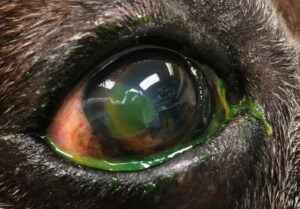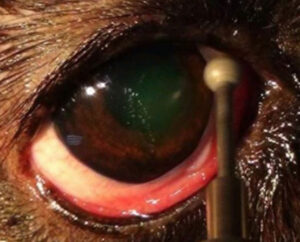What are SCCEDs?
SCCEDs are a type of corneal ulcer that are unique to dogs and can be very slow to heal, making treatment very frustrating for vets and owners. They occur spontaneously in any breed and are more common in older dogs. They form when the top layer of corneal cells (epithelium) does not adhere to the underlying collagen, giving them a characteristic ‘lip’ of loose corneal tissue around the edge of the ulcer.
What are the clinical signs?
- Squinting
- Red eye
- Watery eye
- Rubbing of the face
- Cloudy eye
How are they diagnosed?
Application of a fluorescent dye to the surface of the eye highlights the ulcerated area. The lip of loose epithelium creates a lighter staining ‘halo’ around the ulcer edges due to under-running of the dye. Local anaesthetic drops can be applied to the surface of the eye and a cotton-tipped applicator can be used to confirm the presence of loose epithelium by gently debriding the ulcer edges.
How are they treated?
A diamond-burr is a small hand-held instrument used to debride the loose epithelium and stimulate the formation of new collagen to stimulate ulcer healing. This is ideally performed under sedation to allow thorough debridement and placement of a contact lens, which aids healing and improves comfort following the procedure. Broad spectrum antibiotic eye drops and lubrication are required following treatment, along with a short course of systemic pain relief.
In most cases only one procedure is required, however it is not uncommon for some
ulcers to require repeated treatments. Furthermore due to their spontaneous nature some patients may develop new ulcers in the future.



